Interview: Co-Directors Jeremie Loncka And Rich Loya On (IM)MIGRANTS OF THE STATE At The Actors' Gang
A workshop production created by and based on the real-life experiences of formerly incarcerated actors.
For seventeen years, the teaching artists of the Actors' Gang Prison Project have been creating transformational opportunities for incarcerated men and women. Their latest workshop production, (Im)migrants of the State, is performed by an ensemble of their alumni with over 240 years of combined incarceration who have found their way to freedom and now want to share their stories with audiences. To do so, they have created this entirely new work of theater and are bringing it to The Actors' Gang stage opening March 15. I decided to speak with its co-directors, Jeremie Loncka, who also serves as the Director of Programs for the Actors' Gang's Prison Project, and ensemble member Rich Loya, about their vision for the project and how it came into being with the two of them at the helm. (pictured)
First, I'd like to find out a bit more about each of you which led to co-directed this production.

Jeremie Loncka (pictured), as the Director of Programs for the Actors' Gang's Prison Project, how directly are you involved with programs inside correctional facilities? Do you teach inmates inside or at halfway houses when they are working their way back into society? Or both?
For the last thirteen years, I've been fortunate to work directly with men and women inside the prisons, working alongside them to adapt and develop our programming to fit their needs. Seeing the way they embrace the Actors' Gang physical style of theater, and the way they use it to transform their lives is what has kept me doing this work for over a decade. Over that time span, many of the men and women I met while incarcerated have now gotten out. I can't tell you how rewarding it is, and how much joy it brings me, to now travel up and down the state with them as we continue to build and expand our programming.
We've been working inside reentry on an ongoing basis since 2016. Many of the men and women who have come through our programs now teach with us. As you may know, reentry has become a focal point in recent years because of its effectiveness in helping returning citizens reacclimate as they return to their communities, and individuals who are finishing their sentences can now serve two years at a reentry center. This allows them to start to find employment and reestablish the necessary pillars of support they'll need to reenter society. Our class aids in that process by providing participants with the emotional tools and soft skills that can be helpful in navigating anything from family dynamics to a new job.
Rich, as a member of the ensemble, can you share a bit about your own personal experience within the justice system and how you first came in contact with The Prison Project? And what is your involvement with it now?
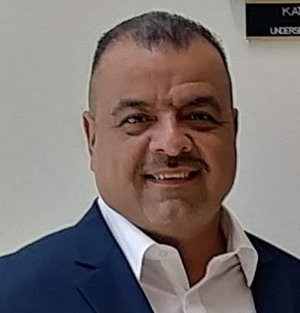
Rich Loya (pictured): At the age of 16, I was tried as an adult, and sentenced to 27 years to life. After serving almost 29 years in the California Department of Corrections, The Actors Gang Prison Project came in to the facility I was at and ran a 7-day intensive workshop with 25 of us participants/inmates, who by normal standards wouldn't have been seen sitting together. A year later, I was found suitable by The Board of Prison Terms and came home after serving nearly 30 years in prison. I've been home now a little over 5 years and am now one of the Program Managers of the Prison Project.
Congratulations to you both on those accomplishments! How did the idea of creating this project get started? And how did the two of you first get involved with bringing it to the Actors' Gang stage?
Jeremie: Rich and I have both dreamed of bringing an Alumni production to the Actors' Gang stage for a long time, but this production started as Rich's idea. We've both spent a lot of time teaching in prisons and sculpting improv-based shows with each other, so our partnership in developing this play was easy. Pulling so many personal stories into one isn't easy, but the challenge has given us the chance to push and play with different theatrical forms and styles to figure out what works best.
Rich: During Covid, we couldn't meet in person. So, our Alumni started meeting on Zoom; all formerly incarcerated people who took the class inside and wanted to continue doing the work out here. During this time, our director Tim Robbins joined and witnessed some of these meetings and saw how we were showing up and playing with full of joy and not letting the "stay at home order" affect us and hinder our work. I remember him calling me one day and asking if maybe we would be willing to share that with the public? Of course, we said yes! From there, Jeremie and I (with the help of the Alumni), figured out how to put 13 stories together into a script.

(Im)migrants of the State ensemble members: (Left to right)
Front kneeling: John Dich, Montrell Harrell, Henry Palacio, Shaun Jones
Back standing: Robert Chavez, Edgar Rodriguez, Scott Tran, Rich Loya
Foreground right: Gregory Leon
Photo credit: Bob Turton
Have the two of you worked on a project together prior to this one? And if so, how is it either similar or different from (Im)migrants of the State?
Jeremie: Rich and I have both created a lot of Commedia-based theater in prisons up and down the state of California. On any given year we will help craft a minimum of sixteen improv-based shows or culminations within the prisons. These are small productions that incarcerated participants of our programs put on for their families. Working alongside each other in the prisons really set Rich and me up well because when you're creating theatre in sixteen different prisons there is a myriad of challenges to overcome. We're both very familiar with cultivating ensemble within the prisons, and the foundation of this show is absolutely ensemble based.
Many of the plays in our prison classes are established through improv, repetition, and memory. However, with this project our Artistic Director, Tim Robbins, gave us the gift of requesting a three-act structure, which really forced us to be articulate about what we wanted to say with the piece.
Rich: Nothing like this before. But when I was incarcerated, as the facilitator of the group, we were putting on a play together, and every six weeks or so, Jeremie and a team of the Prison Project would come in and help us learn how to put it all together. We've also worked together assisting other groups workshop their plays that they create. But this has been so different. We are working with 12 other formerly incarcerated/system impacted people who are trying to navigate life out here, and that has been the most challenging.
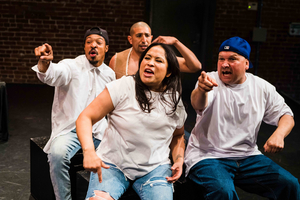
(Im)migrants of the State ensemble members: (Left to right)
Front: Yahaira Quiroz, Henry Palacio
Back: Montrell Harrell, Edgar Rodriguez
Photo credit: Bob Turton
I am curious about whether the project's title has a double meaning, talking both about getting into the system as well as out of it. Is this the case?
Rich: There was a time in the 90's when both Governors, Pete Wilson and Gray Davis stated, "if you (meaning convicted people) took a life, you're spending the rest of YOUR life in prison." So there was a time when a lot of us believed that we were going to spend the rest of our lives in prison. And like myself, many of us were transferred numerous times from one prison to another up and down the state. Most of us are first generation people, and our parents were considered illegal immigrants. (Im)migrants of the State comes from that. And now we are home with our families and living in all different parts of California - the same state in which we were once told we couldn't exist.

(Im)migrants of the State ensemble members: (Left to right)
Front: Montrell Harrell
Back: Robert Chavez, Shaun Jones, John Dich
Photo credit: Bob Turton
No doubt the cast members have a tremendous amount of personal stories to tell about their own incarcerations. How did you decide which tales to include?
Jeremie: The process in a lot of ways took care of itself. The first thing we did was pick themes and work to establish what we wanted to say with the piece. Then ensemble members had the option to write on a certain section of the play if they felt like they had a related experience they wanted to share. If someone took the time to write, we would always try to honor that and include it in some way. The surprise was that a lot of ensemble members felt more comfortable sharing their stories vocally with the group and then trying to act it out together. We would then improvise around the story and sculpt it live in the room together while recording it. Then we'd go back to the recording and type it out. This process prevented us from having a bunch of material that wasn't usable.
What do you think will surprise audiences the most about their stories of life on the inside?
Jeremie: I've never been incarcerated myself, and before I started volunteering to go in and teach in 2010, I didn't know much about our judicial system or the conditions surrounding incarceration. Over the last thirteen years, I've obviously learned a lot about what incarceration looks like in the state of California, and the ensemble does a remarkable job of capturing the harsh reality many individuals are faced with when navigating the carceral system.
Rich: I don't know if they'll be surprised, but definitely will appreciate seeing how much the cast is willing to be vulnerable and share their real truths.
What have you learned about living life to the fullest after working with cast members as they share their stories?
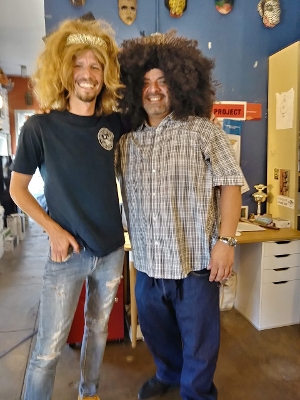
Jeremie: The process has been both difficult and rewarding. But being amongst an ensemble of men and women who are creating this piece with such raw honesty and commitment has been a life-altering experience. The joy and passion they bring to the theater are contagious, and I'm excited for audiences to share that joy. And I'm continually blown away by the thirst and hunger for life that our ensemble brings to the process, many of whom are working multiple jobs, and navigating family and child care, yet they still show up to the theater from 6 pm to 11 pm every night and give everything they have to the play.
Rich: We are experiencing struggles, setbacks, but we are learning to work together - just like we had to do inside - and to build real relationships through ensemble work. And the fact that we've been given this opportunity to tell our stories and share them with the world is humbling and affirms to us all that we have redeemed our past.
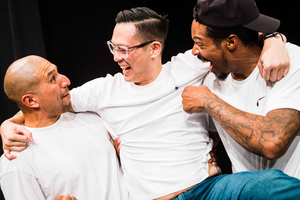
(Im)migrants of the State ensemble members: (Left to right) Edgar Rodriguez, John Dich, Montrell Harrell
Photo credit: Bob Turton
Is it your hope to open your audiences' eyes to the reality of the American justice system and its effect on inmates, hoping to spur us on to get involved for positive change?
Jeremie: Absolutely! I think it's crucial that everyone has a sense of how our correction system runs and who we're incarcerating. The play is designed to be a springboard into a larger conversation, and at the end, it leaves room for audience voices to be heard in what it feels like to witness some of the lived experiences played out. In the future, we plan on following the play up with panels with some of our partner organizations who specialize in the fields of reentry and criminal justice reform.
Rich: The effects are profound, and what we are receiving through this project is that we are continuing to heal the trauma we lived. But we have found ourselves and the value of our lives now. The hope is that people who have no experience with incarceration, can walk away with a different feeling about formerly incarcerated people. That's also true for those who were/are system impacted who can walk away knowing that change is possible.
(Im)migrants of the State by The Actors' Gang has extended as follows:
Wednesday, April 5 at 8:00pm,
Thursday, April 6 at 8:00pm
Note - no performances April 7 to 21
Saturday, April 22 at 8:00pm,
Sunday, April 23 at 2:00pm
Friday, April 28 at 8:00pm,
Saturday, April 29 at 8:00pm
Friday, May 5 at 8:00pm,
Saturday, May 6 at 8:00pm,
Sunday, May 7 at 2:00pm
Friday, May 12 at 8:00pm,
Saturday, May 13 at 8:00pm
Price: $25.00 per ticket.
Tickets: www.TheActorsGang.com
Email: boxoffice@theactorsgang.com
Phone: 310-838-4264.
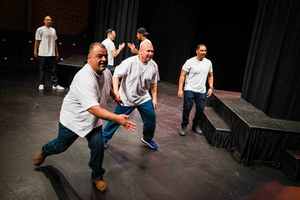
(Im)migrants of the State ensemble members: (Left to right)
Front: Rich Loya, Henry Palacio, Robert Chavez
Back: Edgar Rodriguez, John Dich, Montrell Harrell
Photo credit: Bob Turton
About The Actors' Gang Prison Project
The Actors' Gang Prison Project is an internationally recognized rehabilitation program currently running in 14 California state prisons, 2 Reentry facilities, and Los Angeles County Probation camps and halls for juveniles. The program starts as a 7-day, 4-hour-a-day intensive theatrical arts program which transitions into an ongoing weekly peer-led class, managed by the program director and overseen by TAG Alumni Teaching Artists. Using a highly physical and emotional style of theater as a tool, the program creates a supportive space in which the participants can express their fears, choose empathy over anger, overcome gang barriers, and most importantly, prepare for life beyond bars.
After working inside California state prison for almost a decade, the Prison Project recognized the need for the reach-in rehabilitation process to continue beyond one's sentence end date and began a weekly reentry program, The Actors' Gang Reentry Project for men at Walden House/Health Right 360 in Los Angeles. This partnership provides a welcoming space for new participants and has given qualified Prison Project participants at the end of their sentence a residence where they have the opportunity to continue programming as they transition from prison to their community. Focusing on providing an avenue for upward mobility with meaningful employment as Alumni Teaching Artists, there are currently 56 formerly incarcerated participants in the Alumni Advocacy Project, and 19 of them work as Teaching Artists.
Of the original 25 men that joined TAGPP during the first year at Avenal State Prison, 18 had Life sentences. 17 of the 18 have gone before the Board of Prison Terms and have been found suitable for release and are freed. 22 of the original 25 are now home. A recent study shows 77% Employment Rate for The Actors' Gang Reentry Program participants.
This project is made possible by support from The Andrew W. Mellon Foundation. The Andrew W. Mellon Foundation is the nation's largest supporter of the arts and humanities. Since 1969, the Foundation has been guided by its core belief that the humanities and arts are essential to human understanding and that everyone deserves the beauty, transcendence, and freedom that can be found there. Through their grants, the Foundation seeks to build just communities enriched by meaning and empowered by critical thinking, where ideas and imagination can thrive. Learn more at mellon.org.
Comments

Videos
